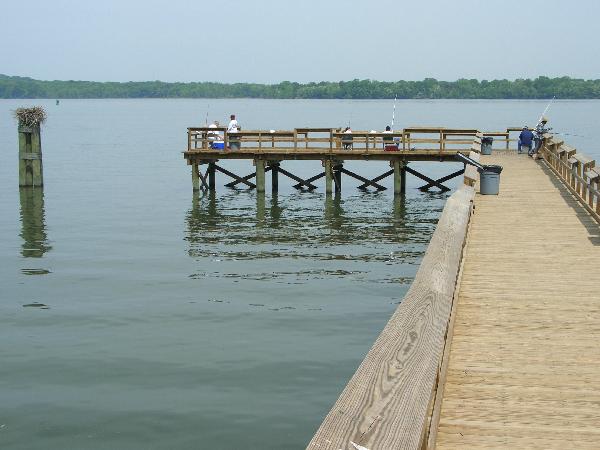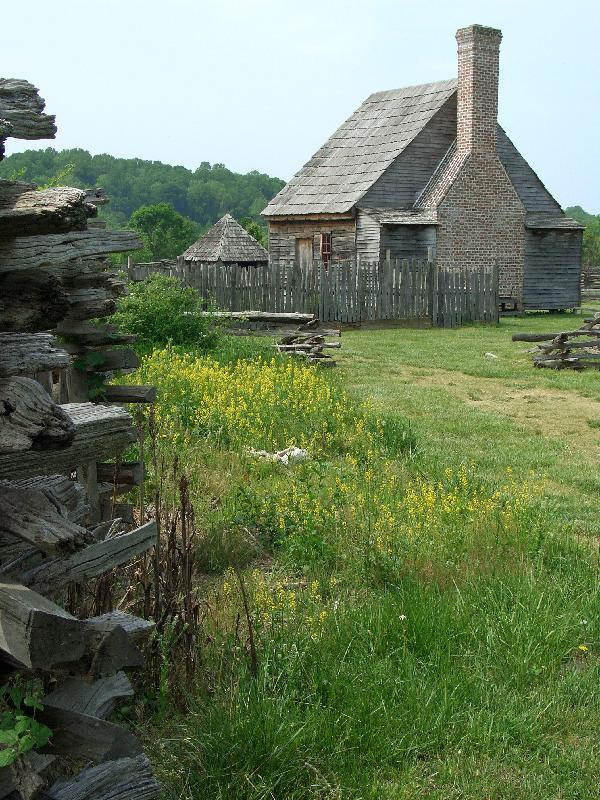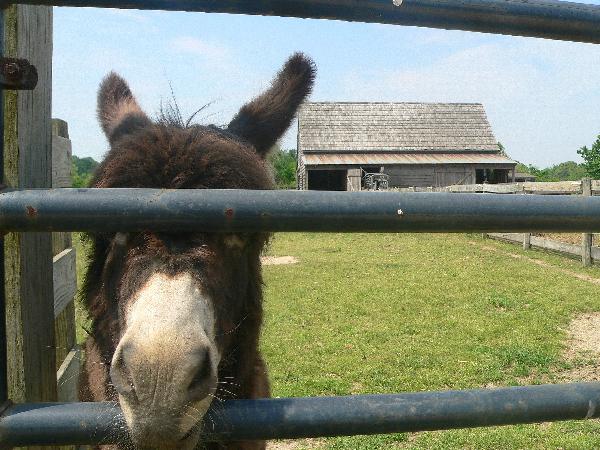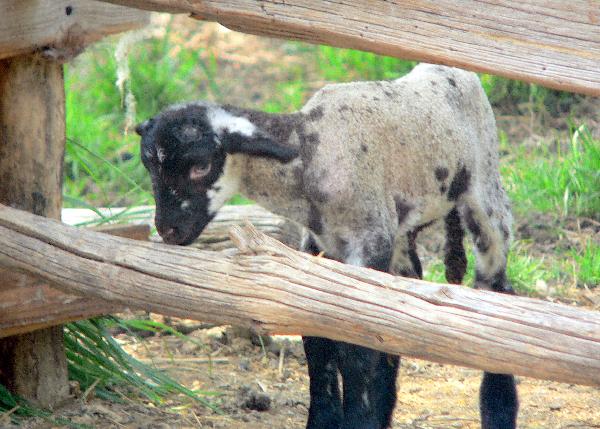NPS Website; Local Piscataway Park Website; National Colonial Farm Website
 WHAT IS IT?
WHAT IS IT?Six miles of prime Potomac River bordering real estate that became a National Park in 1961 in order to provide pristine, 18th Century-worthy views from George Washington’s plantation home, Mount Vernon, located directly across the water. The Park includes the privately run National Colonial Farm, a living history museum that depicts a circa 1770 middle class Virginia family’s tobacco farm.
BEAUTY (5/10)
At Piscataway Park, the wide Potomac’s banks stretch for miles, untamed by most industrial and residential intrusions. An L-shaped pier gingerly enters the waters providing ample fishing opportunities to patient anglers. A rogue pier stanchion hosts an osprey nest. Its resident raptor provides an exciting show, hovering, swooping and capturing an unsuspecting fish.
Stately Mount Vernon demands attention and we obliged. Our binoculars revealed hundreds of tourists meandering around its grounds. Maybe we won’t visit today after all.
The National Colonial Farm feels very museum-ish. Its buildings are beautifully preserved, its lawns are impeccably mowed and its fences are in perfect condition. Its carefully selected Heritage Breed Animals also look quite content. This Colonial Farm does not have the lived-in appearance earned by northern Virginia's Claude Moore Colonial Farm.
HISTORICAL INTEREST (5/10)
While the National Park Service was thinking about a project to protect the views of Mount Vernon, the Accoceek Foundation rose to the occasion and began purchasing the land to do so. The Foundation formed for the sole purpose of preserving this stretch of the Potomac riverbank and in doing so, became one of the nation’s first land trusts.
The Accoceek Foundation’s stewardship of the National Colonial Farm in Piscataway Park, including its organic gardens and heritage breed livestock contributes to the knowledge base and gene pools necessary for ecologically sound farming today. Their living history presentations portray middle-class existence before the American Revolution, the day-to-day life of a new and growing part of New World society.
 CROWDS (7/10)
CROWDS (7/10)Clusters of school children were being shepherded through the National Colonial Farm by able volunteers. The groups were scattered sufficiently so we could eavesdrop when the conversations sounded interesting but our progress through the farm was never impeded by them. Plus, the presence of buses full of kids guaranteed that the seasonal gift store (and home of NPS passport stamps) would eventually be open.
EASE OF USE/ACCESS (3/5)
The Piscataway Park and National Colonial Farm are located approximately 15 miles from the DC Beltway (I-495, 95). From either Exit 2A or 3A take the Indian Head Highway (Maryland Route 210) south for about ten miles.
The ultra specific Accokeek Foundation directions then read as follows: “After you pass Farmington Road, you will take a right at the next stop light onto Livingston Road (look for B&J Carryout). Drive one block and turn right on Biddle Road. At the stop sign, turn left on Bryan Point Road and follow 3.5 miles to the end. Make a right into the visitors parking lot.” We would be hard pressed to get more specific.
CONCESSIONS/BOOKSTORE (5/5)
We would have been pretty disappointed if the door had remained locked and our only view of the Museum Gift Shop was through a thick window. Even from that vantage, the goods looked inviting. Once the store opened, Gab predictably made a beeline for the Sale table but was sidetracked by the numerous displays and items celebrating the “item of the month” which happened to be natural herbs.
Tea sets, pottery, and all sorts of things about organic gardening fill the tables and shelves. Teas, candles, soaps and of course, herbs scent the air. Although there are children’s books and items here, the Shop slants towards the mature customer. Not a lot of field-trip friendly doodads and trinkets here, so not a lot of pint-sized visitors. Probably a good move since the teacup display looked pretty precariously placed.
 COSTS (3/5)
COSTS (3/5)Admission into Piscataway Park is free. If you want to enter the National Colonial Farm, it is $2 per person.
RANGER/GUIDE TO TOURIST RATIO (4/5)
We didn’t encounter our first NPS Ranger until we knocked on his Office door. Interpretive duties at the National Colonial Farm are left in the hands of its founders, the Accoceek Foundation.
The walk from the Park Office back through the Colonial Farm exposed more familiar brown shirts, even more costumed interpreters from the Foundation, and ended at the wonderful and now-staffed museum shop.
TOURS/CLASSES (7/10)
The best thing about the National Colonial Farm is its contrast to its wealthy neighbors at Mount Vernon and its poorer peers at Claude Moore National Historic Site. National Colonial Farm paints a vivid picture of what a middle-class; somewhat upwardly mobile plantation farm would have looked like over 230 years ago. We drew on our previous day’s experience at Claude Moore to talk about the various social classes and conditions with an interpreter we met as we were leaving the Farm.
Unlike our hosts at Claude Moore, this interpreter felt free to shift in and out of character, which we truly appreciated. We had spent the morning marveling at the sprawl that was Winthrop and we wanted a local’s (modern) point of view. She also clarified some of our questions from Claude Moore’s which came across as anachronistic when we asked our resolute farmers.
FUN (8/10)
Baby lambs! We saw two baby lambs. As in, just been born baby lambs! A volunteer was explaining to a group of wide-eyed kids, us included, one of the lamb’s present predicament. The little guy had managed to get himself on the side of the fence opposite his mom, who was already taking a stronger liking to his sibling. If he couldn’t find his way back to his mom and back in her good graces, he could starve before the week was through. Come on baby lamb! You can do it!
 The drama, the suspense! You know it had to be good to keep a dozen 4th graders rapt in silent attention. When we weren’t gawking at sheep or chatting away with living history presenters about the population and landscape of Northern Virginia – both 18th and 21st century – we hung out with a disinterested burro and some exotic turkeys.
The drama, the suspense! You know it had to be good to keep a dozen 4th graders rapt in silent attention. When we weren’t gawking at sheep or chatting away with living history presenters about the population and landscape of Northern Virginia – both 18th and 21st century – we hung out with a disinterested burro and some exotic turkeys.WOULD WE RECOMMEND? (5/10)
Piscataway Park and National Colonial Farm would be a fine compliment to any visit to Mount Vernon. The Site allows its visitors to take a break from the crowds and enjoy different perspectives, scenic and social, of Mr. Washington’s estate and the 18th century Maryland/Northern Virginia countryside. Its affordable admission ensures that you can extend your excursion without overextending your vacation budget.
TOTAL 52/80
www.usa-c2c.com
© 2004-06